How great is the Internet! One of the most impactful, viral, influential services you can perform online is to read stuff and tell people what you like.
It’s true!
If you’re looking for a competitive edge, a way to establish your authority, a way to get more followers, one of the best, proven paths to online success is content curation.
It’s both as simple and as difficult as finding great content and sharing it with your audience. The difficult part is that there is a lot that goes into a world class content curation strategy. Where do you look for content? How do you find the best stuff? How do you find the time to find the best stuff? And then of course, what do you do with it all once you find it?
These are fantastic questions, and they’re just the type of challenges we’d love to help you solve. We’ve partnered with the folks at Pocket, who’re a huge part of our curation process, to share our research and lessons with you about how to build a remarkable (and remarkably effective) content curation strategy.

What we hope you’ll learn in this post
Content curation is a favorite topic among us on the Buffer team, and we’re so happy to have a chance to share our best tips with you. To make it easier to find the parts of this resource that are most helpful, here’s a look at all we’ll cover.
Click to jump to any section:
- The one-a-day formula for great content curation
- Content curation tools
- Where to find great content
- Advantages of being really good at content curation
- Who does it well: Curation heroes
- Curation automation
Get this post as an e-book!
Huge thanks to the team at Express Writers who put together this free e-book with all the content from this article. If you’re up for downloading and reading, click the image below to get your free copy.

The one-a-day formula for great content curation
Successful curation can be split into these three areas:
- Discover
- Read
- Share
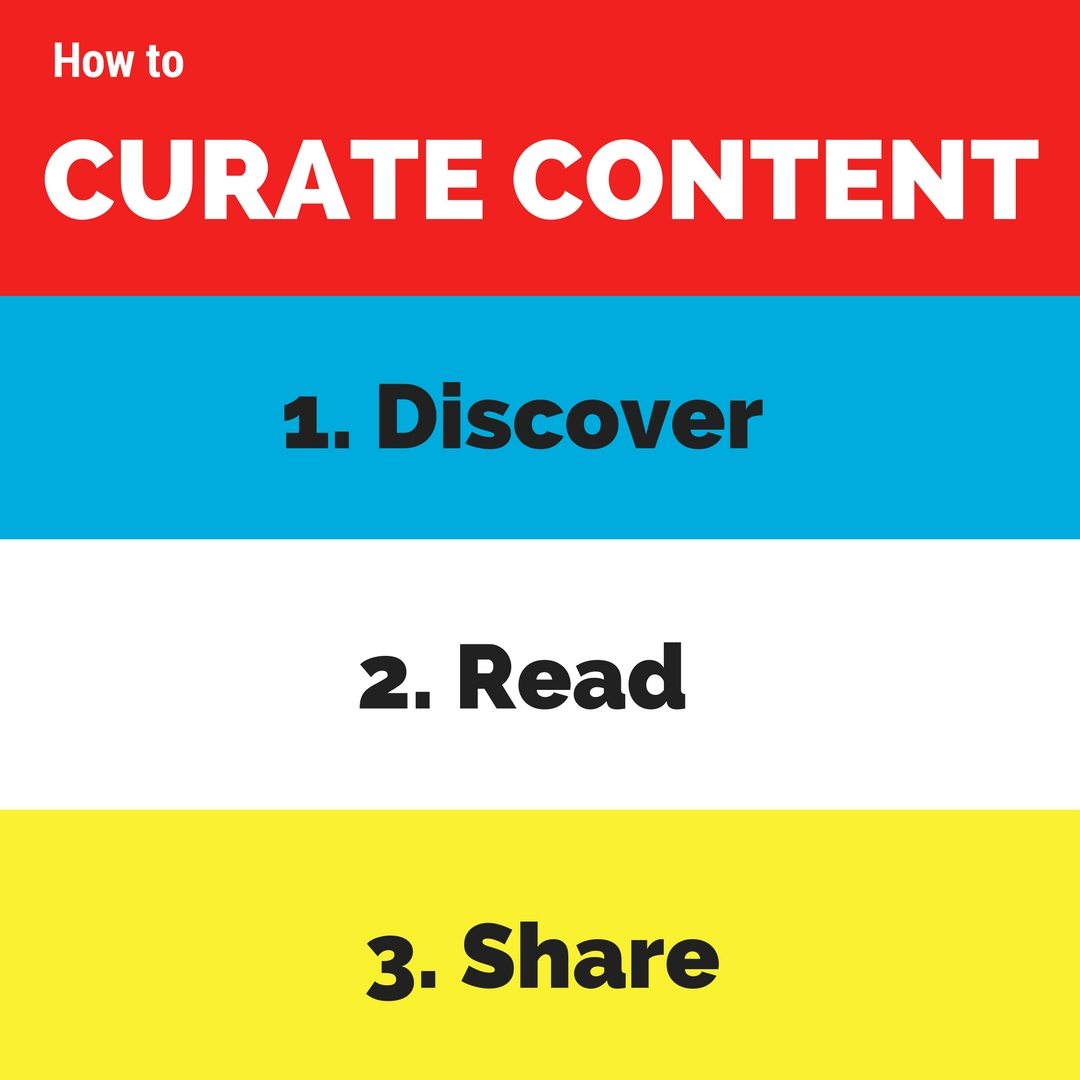
From a high level, those three elements are all you need to master in order to get really good at content curation. Exciting, right? That’s not too much to ask! Of course, the really great content curators know that a detailed, comprehensive, strategic approach to each of those three steps is really what sets apart great curation from the rest.
I’d love to share how to get this comprehensive, strategic approach for yourself.
Let’s start by looking at a sample curation day (it just so happens to be my day), and all the different detail that goes into the Discover-Read-Share formula.
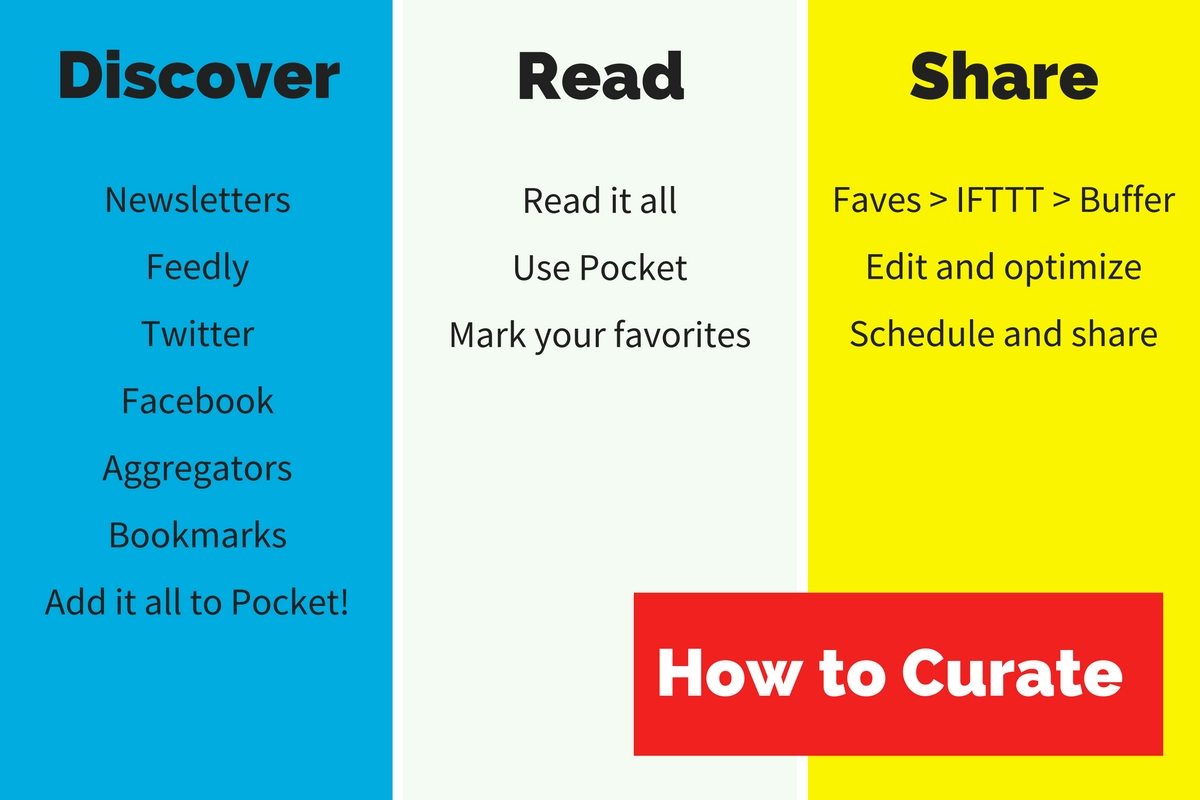
Discover
- Check your newsletters for interesting stories. Add to Pocket.
- Check Feedly for interesting stories. Add to Pocket.
- Check Twitter for interesting stories. View by list and hashtag. Add to Pocket.
- Check Facebook for interesting stories. Add to Pocket.
- Check aggregation sites like Inbound.org, Growth Hackers, Hacker News, Panda, Digg, etc. Add anything interesting and relevant to Pocket.
Read
- Read everything in Pocket
- Mark shareworthy content as “favorite”
Share
- Favorite content is automatically added to Buffer via an IFTTT recipe
- Browse the Buffer feed to adjust titles, images, hashtags, and mentions.
- Schedule or share
Total time (once you get in a good flow): 1 to 2 hours each day.
As you may know, reading articles online can take far more than one to two hours per day. It can take all day! (And what glorious days those are.)
However, there are very few of us who are able to curate content full-time for a living. We’re likely curating as a guilty pleasure, while the other demands of the job beckon us. So it’s vital to be ruthlessly efficient with your curation strategy.
How?
Here are some tips for each of the three key parts to a daily content curation workflow.
Tips on how to discover content, fast
- Curate from curators – newsletters, communities, etc.
- Have a list of 25 (maximum!) go-to content sources
- Follow interesting people and make it easy to see what they share
- Give new content sources a probationary period
Seventy-five percent of any curation strategy is discovery.
In fact, you should be spending 95 percent of your time in discovery and reading; only 5 percent should be spend on sharing. (More below on how to make this a reality.)
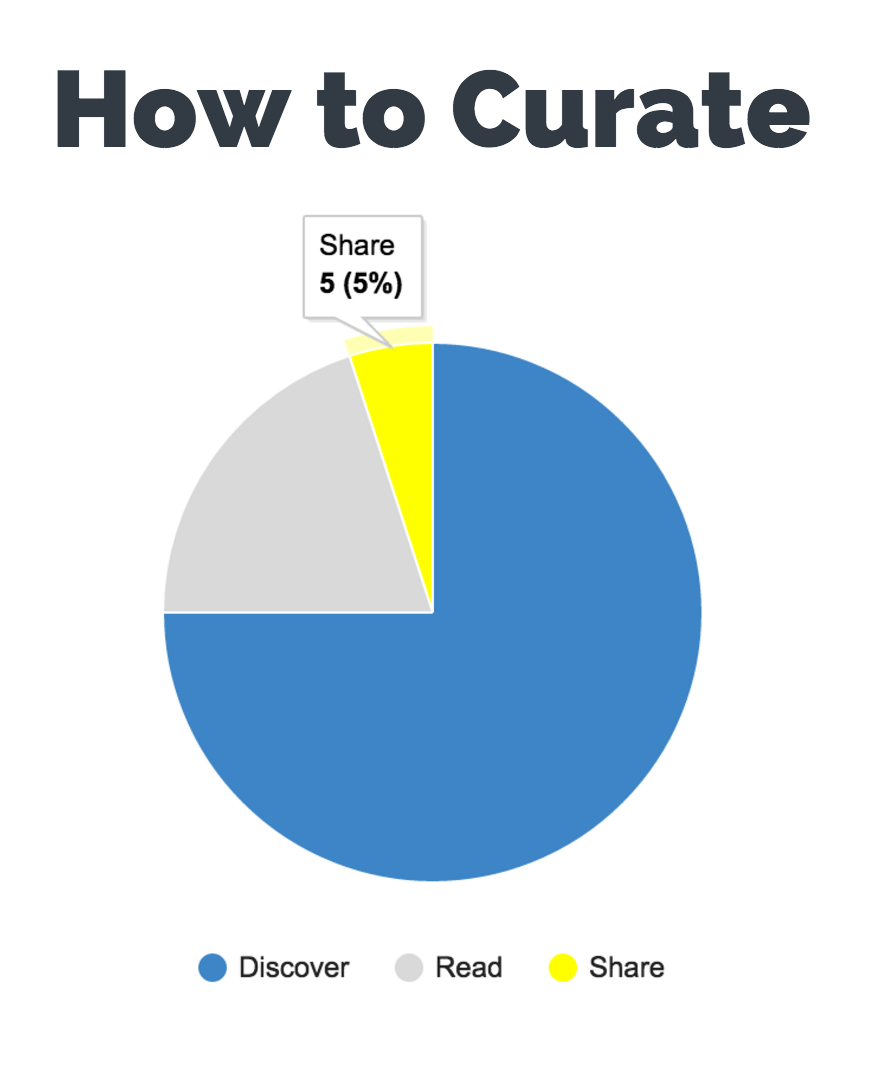
With discovery being the bulk of the curation process, it’s okay if it feels like it’s taking more time than it should. Give yourself the time and space to discover. This is where the true content curation all-stars shine: They find the stories that no one else is finding. They guard their secret sources like family jewels and are always willing to spend the extra few minutes diving deeper into a rabbit hole in hopes that a new wonderland is in there.
1. Curate from curators – newsletters, communities, etc.
One of the biggest hidden secrets of curation superstars: They curate from curators. They subscribe to newsletters full of hand-picked links from peers and neighbors. They browse communities where stories are gathered and upvoted — crowdsourced curation, more or less. If you’re in the marketing space, newsletters like Teachable’s MakeChange and sites like Inbound.org are curation gold.
Here’re a few interesting places to look if you might be keen to find curators in your niche (more on these places below):
- Pocket’s Recommended feature (easily accesible from within the Pocket app)
- Curated’s featured publications
- Letterlist’s list of newsletters
- Panda’s integrations
Curating from curators helps to build a good base of discoverable content.
Then you have to go a bit deeper.
You have to have your own go-to places to find content that few others have found. These are your go-to sites — maybe an unknown blog, or a low-traffic section of a major news site. For instance, I adore the writing on Post Planner, and I love reading the New York Times’s tech blog. (Whoops, there go my secrets.)
To discover places like these, it helps to keep an open mind for curation when clicking through newsletter links or community upvotes. Do the sites themselves seem to resonate with what you’re wanting to find? Here are some questions to ask:
- How often do they publish new content? (or, how old is the article I’m reading now?)
- If I like this author, does she contribute often, or is this a guest post?
- How well is the article formatted? (This hints at a certain level of content quality.)
- How well is the site designed?
And then of course, once you find these hidden spots, make it easy to visit them daily.
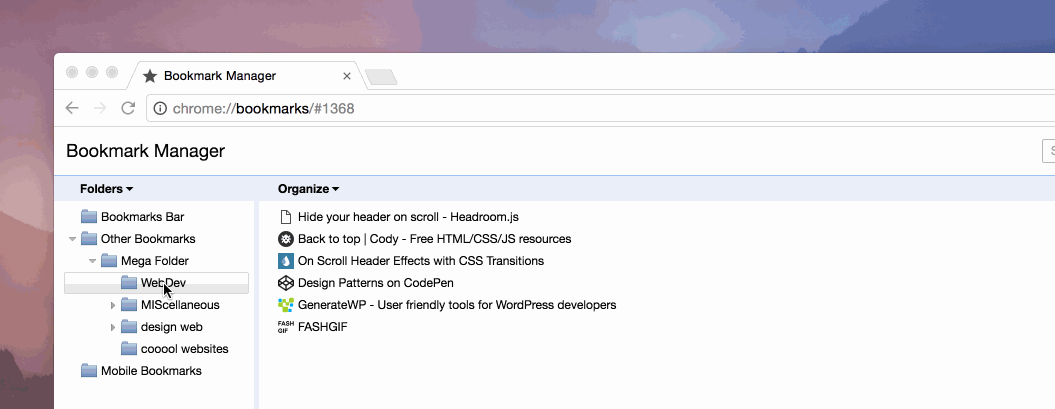
2. Have a list of 25 (maximum!) go-to content sources
While you’re building out your Top 25, make sure to keep it at no more than 25. Yes, there may be more than 25 great sites out there, but remember that your ultimate goal with discover is finding the best, original stuff — and your secondary goal is speed and efficiency.
If you have more than 25 sites, you’ll be too busy filtering and hunting. Besides, if your list is more than 25, chances are they aren’t all sites that are original to your discovery. Other curators are probably curating them, in which case you can curate those curators.
Feedly, an awesome RSS tool we’ll cover more below, is where I keep track of my list of sites to follow. Currently I follow 25 total blogs on writing and marketing.
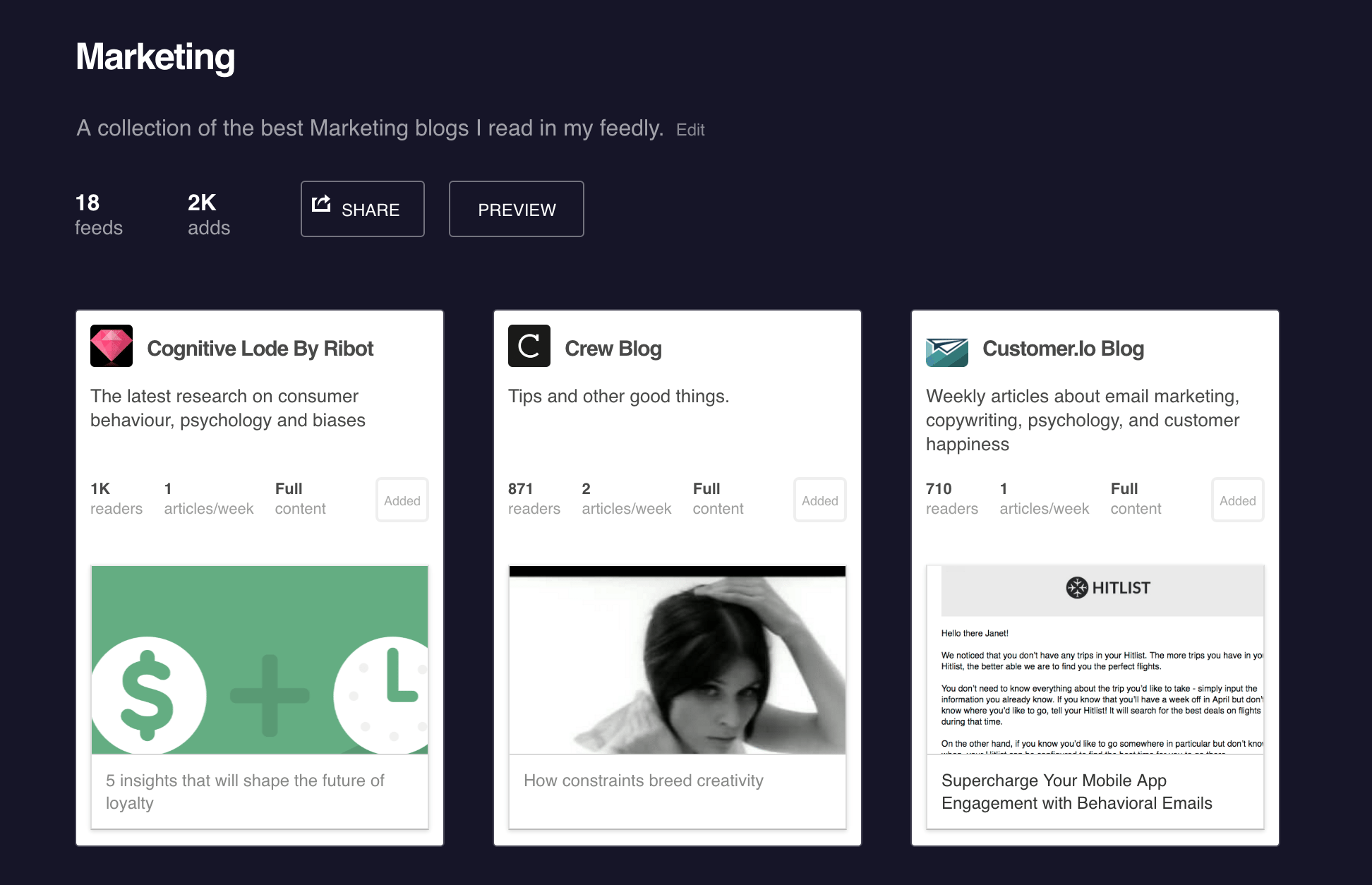
3. Follow interesting people and make it easy to see what they share
Along with unique sites, it helps to follow unique people. Take Matt Navarra of The Next Web, for instance. Here is a sampling of recent tweets. The man is a cornucopia of fascination:
Twitter now lets you use any emoji in your account name or bio 😎👌💥 https://t.co/1eKOPhAPZI
— Matt Navarra (@MattNavarra) August 24, 2016
YouTube may soon be a social network with text, image posts https://t.co/BcY1Ga7J42 pic.twitter.com/juQOlwfJOs
— Matt Navarra (@MattNavarra) August 25, 2016
Twitter's new Message button lets people DM you from your site https://t.co/dsAqHdFtxT pic.twitter.com/cMxXXT7QxL
— Matt Navarra (@MattNavarra) August 25, 2016
There are unique people like this in almost every industry (Matt just so happens to be in social media) — and if there aren’t, then wow what a great opportunity for you to be the first!
One way to find them is with a hashtag search. If you have a particular keyword or two that is central to your brand or area of expertise, look for people sharing content with that keyword. Sort by most followers if you can.
Another way to do it is to see who is sharing the articles that you think are pretty great. If someone else has found your secret best stuff, then they probably are a good one to follow. To do this …
- Enter a URL into BuzzSumo
- Click the “View Sharers” button next to the article’s title on the results page
- Voila! See who has shared this content
(Viewing sharers is a BuzzSumo Pro feature that you can try out for free with a trial.)
And if all else fails, you can try following people with a similar job title or from particular companies you admire or compete with. This’ll make sure that you’re staying on top of the stories that are relevant to people like you.
Of course, following all these folks is one thing. Being able to see their content in the stream of all content is another. You can do the bookmark hack and travel directly to their feeds every day (not a bad idea). You can try a tool like Nuzzel, which emails you a digest of what your Twitter friends and Facebook friends have shared the past 24 hours (ranked by virality).
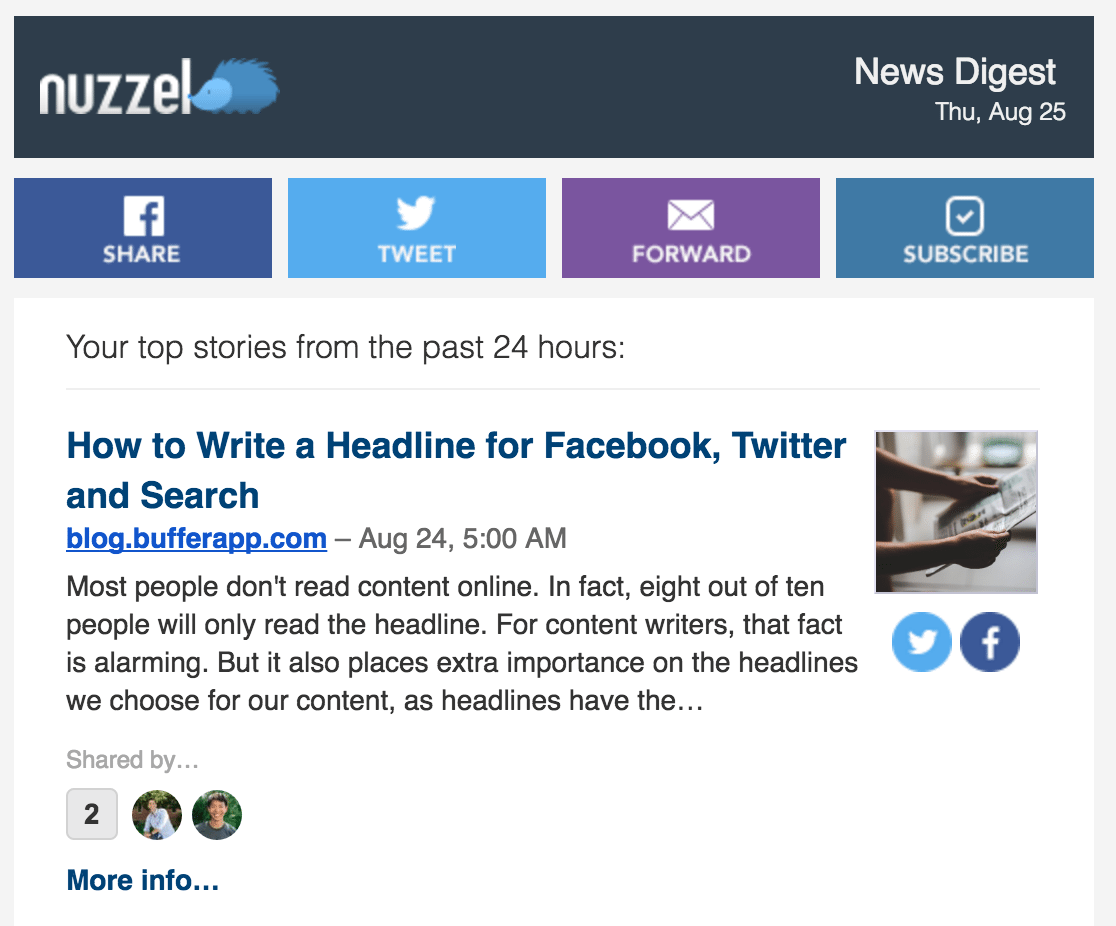
Or you can make yourself a second profile.
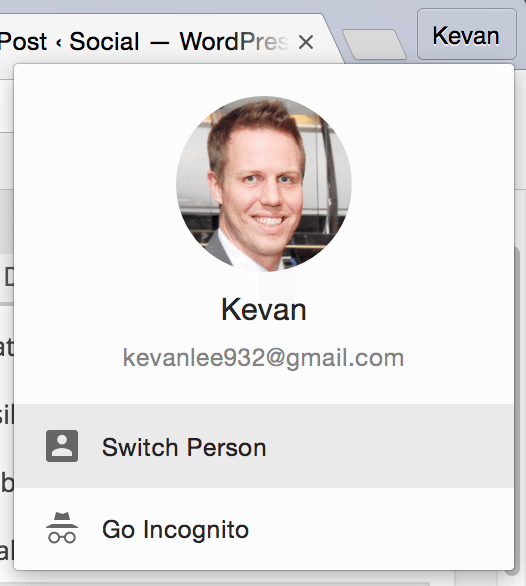
4. Give new content sources a probationary period
As you come across new websites and publications, definitely feel free to add them to your repertoire — eventually. In my experience, I’ve found that a site might look promising for a day or two, though it takes at least two weeks before you can know for sure if it deserves to be a place you visit every day.
Likewise, it’s beneficial to be quick to cut any sites that aren’t quite passing muster for you lately, too.
Your time is valuable! Being a great curator means staying cutting edge with where you look and how long you look there.
Tips on how to read content, fast
- Get a read-it-later app (like Pocket)
- Stop reading as soon as you know if it’s a yes or no
- If it doesn’t hold your attention, it won’t hold your reader’s
- It’s okay to skim, within reason
- Sometimes images make the best text
Good news is, the hard part (discovery) is behind you. Now you get to read!
1. Get a read-it-later app (like Pocket)
First things first. One of the toughest things you can do when it comes to curating content fast is to read every article on the site itself. You need a read-it-later app.
This plays into the concept of batching.
Batching (or batch processing) is the act of grouping similar tasks together that require similar resources. Doing so streamlines the process and helps you get more done, faster.
It’s a concept you might be familiar with from Tim Ferriss’s Four Hour Workweek or articles like this: How Batch Processing Made Me 10x More Productive. It’s a popular lifehacking and productivity tip, for sure! And it works great with curation.
Batch the tasks that require similar resources.
- Do all your content discovery at the same time, while your brain is in the hunting mentality.
- Do all your reading at the same time, while your brain is feeling reflective and choosy.
And in order to read in a batch, you need to have a tool that lets you save the articles you find in order to read them later.
I use Pocket for this. It has a neat card layout to quickly see everything I’ve saved. It strips out all the extra sidebars, styles, and ads so that you’re just reading what the author wrote and intended. And it has a wonderful browser extension that lets me save new articles to Pocket with one click from any page on the web.
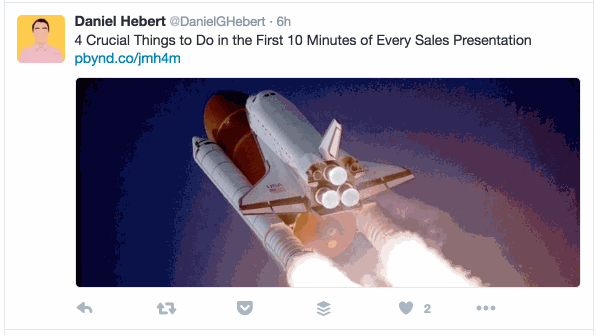
2. Stop reading as soon as you know if it’s a yes or no
Now that all your content is flowing in through Pocket or another read-it-later app, you can start the process of reading. And apologies if I seem to be mentioning ruthlessness a lot in this article. You’ll want to be pretty ruthless here, too.
As soon as you know if it’s a yes or a no, you must stop and go onto the next one.
Here are some reasons why it can be a yes:
A really great article! ????
An amazing image or graphic ???
A fantastic quote ??
An interesting statistic ?
Here are some reasons why it can be a no: Everything else.
3. If it doesn’t hold your attention, it won’t hold your reader’s
If you find your attention faltering, stop reading. You are likely the most invested person in the world in this article. If it can’t hold your attention, it won’t hold the attention of a far less invested reader!
If you realize it’s not as actionable or interesting as you thought, stop reading.
If you’ve read something similar elsewhere, stop reading.
In general terms, these are some factors that make for a really great, curate-worthy article:
- It’s unique
- It’s interesting
- It’s useful
(These go by the vowel-heavy initialism UIU.)
The faster you can find U, I, or U, the better off you’ll be with your speed of curation.
4. It’s okay to skim, within reason
First and foremost, read every article. Only in emergencies, skim read.
Sometimes, you might find yourself really rooting for an article to succeed. And you just really want to get to the good stuff. Well, awesome – there is a time for skimming, and this might very well be it.
Of course, skimming comes with its risks. What if you skim over an offensive or inaccurate portion of an article, then choose to endorse it unwittingly? It’s not a great feeling (spoken from experience). One way to work around this hazard is to excerpt only the portions that you’ve read. For instance, you might say:
- Great post! Loved this section on growth hacking in particular.
- Wonderful line from this blog post: ““The reason that most of us are unhappy most of the time is that we set our goals not for the person we’re going to be when we reach them, but we set our goals for the person we are when we set them.”
This way, you’re only vouching for the parts that you did in fact read.
5. Sometimes images make the best text
Similarly, while skimming, it’s possible that a picture might catch your eye, rather than the text itself.
This is perfectly fine.
If you’re in the business of curating unique, interesting, and useful stuff, it matters little whether it’s sensational text or sensational images.
And as a bonus, skimming for great images is a breeze. Some read-it-later apps strip out the images from within the body of articles; Pocket grabs the article’s main image and uses it as a thumbnail on the post. Otherwise, you may be able to spot a great image well before you save to Pocket, during the discovery phase of curation.
Tips on how to share content, fast
- Get a social media scheduling app (like Buffer)
- Set up an automation workflow
- Invest in a good email solution
Like I mentioned above, the sharing of curated content needs to take only five percent of your overall curation workflow. If you spend an hour-and-a-half on curation, you can do all the sharing in as little as five minutes.
1. Get a social media scheduling app (like Buffer)
It starts with a solid foundation: a social media management dashboard. These are great for managing multiple social accounts on multiple channels, all in the same place. For instance, we use Buffer to manage our Facebook, Twitter, Instagram, Pinterest, LinkedIn, and Google+ accounts, plus the accounts of our individual profiles (like, in my case, all my Kevan Lee profiles).
What’s more, social media dashboards like Buffer also come with scheduling.
This is uber-important for a curator especially.
Picture this, you’ve just gone through the discovery and reading phases of curation, and you have 15 cool articles to share. What do you do with those 15?
You can share them all at once as a burst, which has been scientifically proven to lose you followers.
You can space them out over the course of the day by manually sharing one every 45 minutes (which has been qualitatively proven to be a pain).
Or, you can add them all at once to Buffer, and Buffer will send them for you at the pre-appointed schedule you’ve set. ?
Here’s a video that explains the calendar feature within Buffer:
2. Set up an automation workflow
To make this even more powerful, you can set up automation workflows that allow for the bulk scheduling to happen seamlessly. I’ll get into lots more detail below about how this particular automation can happen.
Basically, you can use a tool like IFTTT or Zapier to connect your favorite read-it-later app like Pocket to your favorite social publishing tool like Buffer. Then, whenever you take a particular action while you’re reading — say, marking something as “favorite” — IFTTT or Zapier will tell Buffer to do a particular something else — say, add to your sharing queue.
In addition, there are some neat, native integrations with content tools like Pocket and Feedly and sharing tools like Buffer. For instance, from Pocket’s web app, you can share any article directly to Buffer. (The same can happen on mobile, with Buffer’s share extension turned on.)
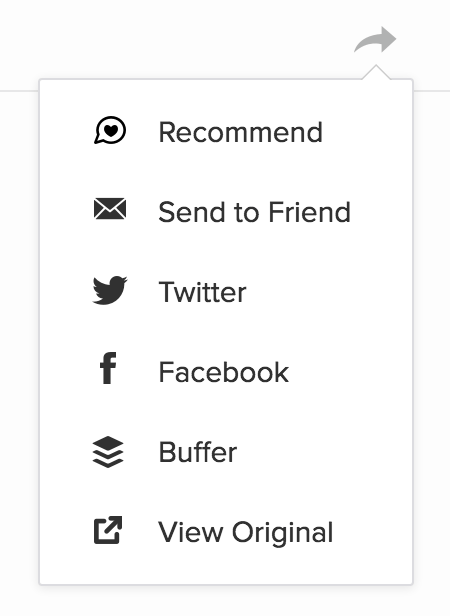
3. Invest in a good email solution
Similarly, if your curation strategy relies more on email for spreading your content, there are some awesome automation tools to help with email. There’s the IFTTT and Zapier automation flows for capturing favorite links, and there are even standalone tools that allow you to build an email newsletter as you read.
Speaking of tools, let’s get to know a few.
The content curation tools behind great newsletters, roundups, and lists
Great curation can vary widely, from the most manual of processes (copy-paste to spreadsheets) to the most automated (tool-connected tools). We lean a bit toward the tools side at Buffer, particularly when it comes to working as smart as possible.
These are the tools we use personally or can recommend highly. Hope you spot one or two that might work for you also.
1. Buffer – https://buffer.com
Social media scheduling, publishing, and analytics
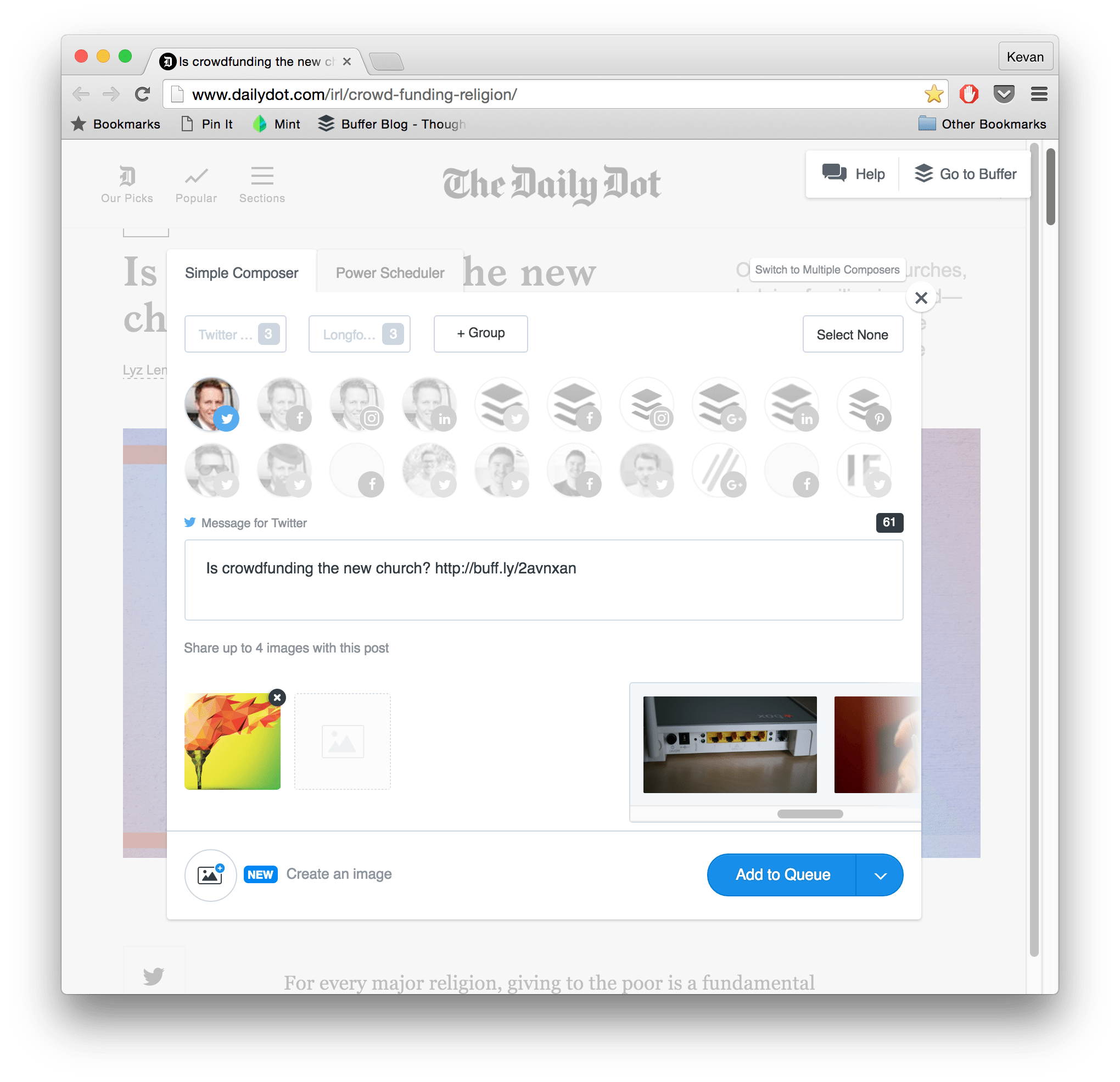
Price: Free
Buffer is the key to our fast-sharing curation. We’re able to go in from Day One and set a custom schedule, based on when our tweets and posts tend to get the most engagement (Buffer tells you this; thanks, Buffer!). Then this schedule stays for as long as we like: All we need to do is fill a queue with the curated content that we find, and everything else takes care of itself.
The browser extension makes it easy to add content from anywhere, too. Just click the Buffer button on any page, or press Option+B, to open the Buffer window.
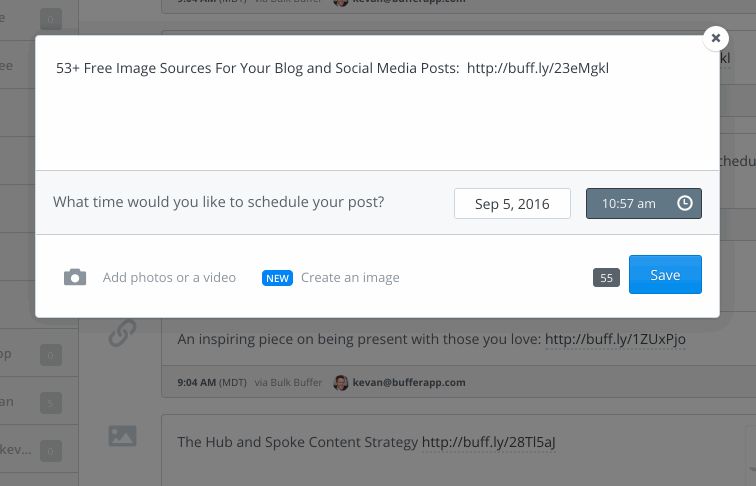
Other options:
Hootsuite, Sprout Social, Sprinklr
2. Pocket – https://getpocket.com
Read-it-later app with social content
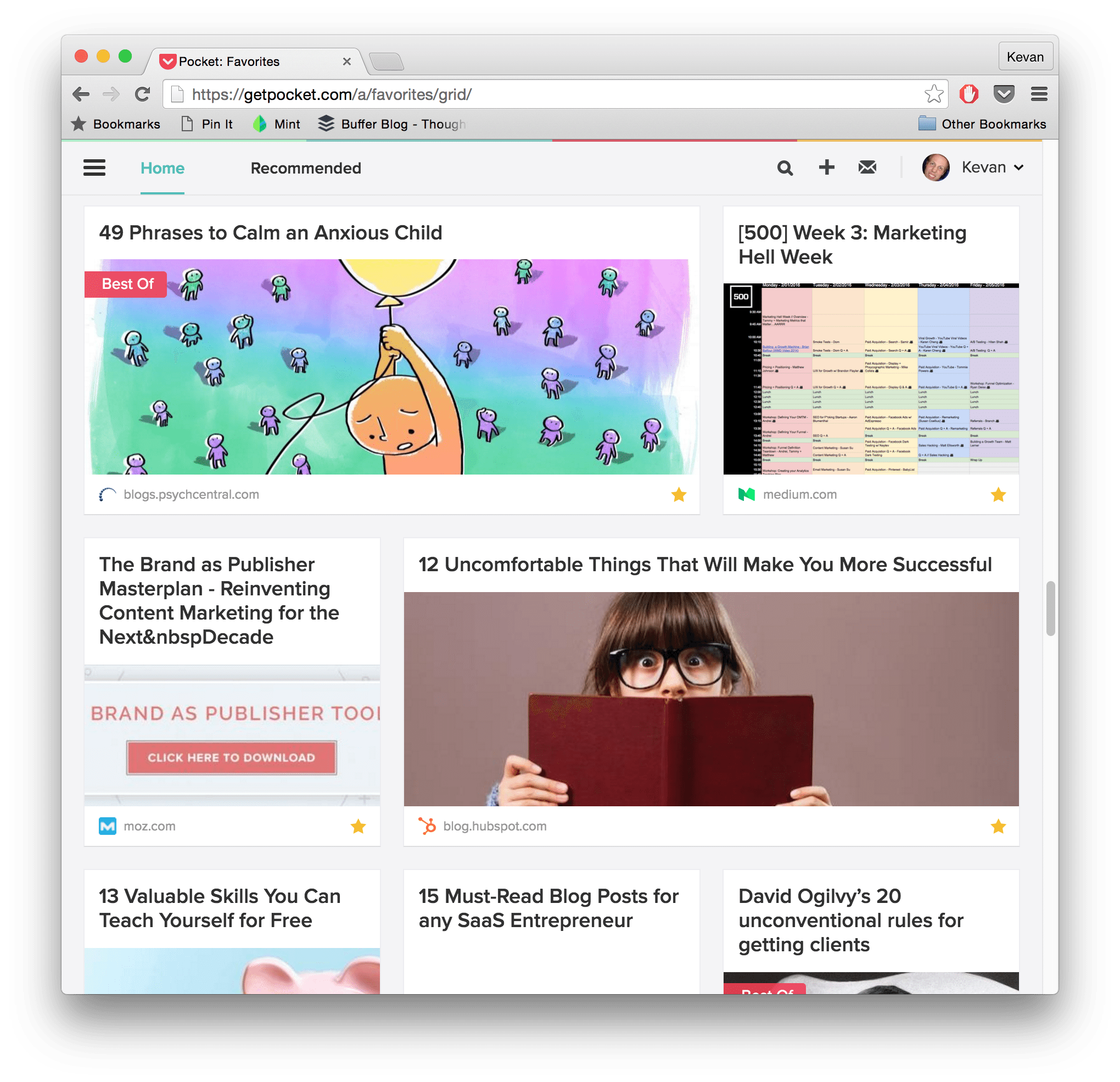
Price: Free
This is the reading app for online content. What we do is save everything we find to Pocket and then set aside time to read it all. Each post is stripped of all superfluous design so we can concentrate on just the words. And it’s super easy to share from Pocket with its many social social features and integrations.
You can even Recommend items with others on Pocket, and cross-post to Twitter and Facebook at the same time. Recommendations on Pocket will appear on your Pocket profile and in your followers’ feeds when they’re looking for great content to read, like and repost.
If you’re ever strapped for time (or doing other tasks), Pocket will even read the articles to you. Yup! You read that right!
Other options:
3. Feedly – http://feedly.com
Robust RSS reader with content discovery
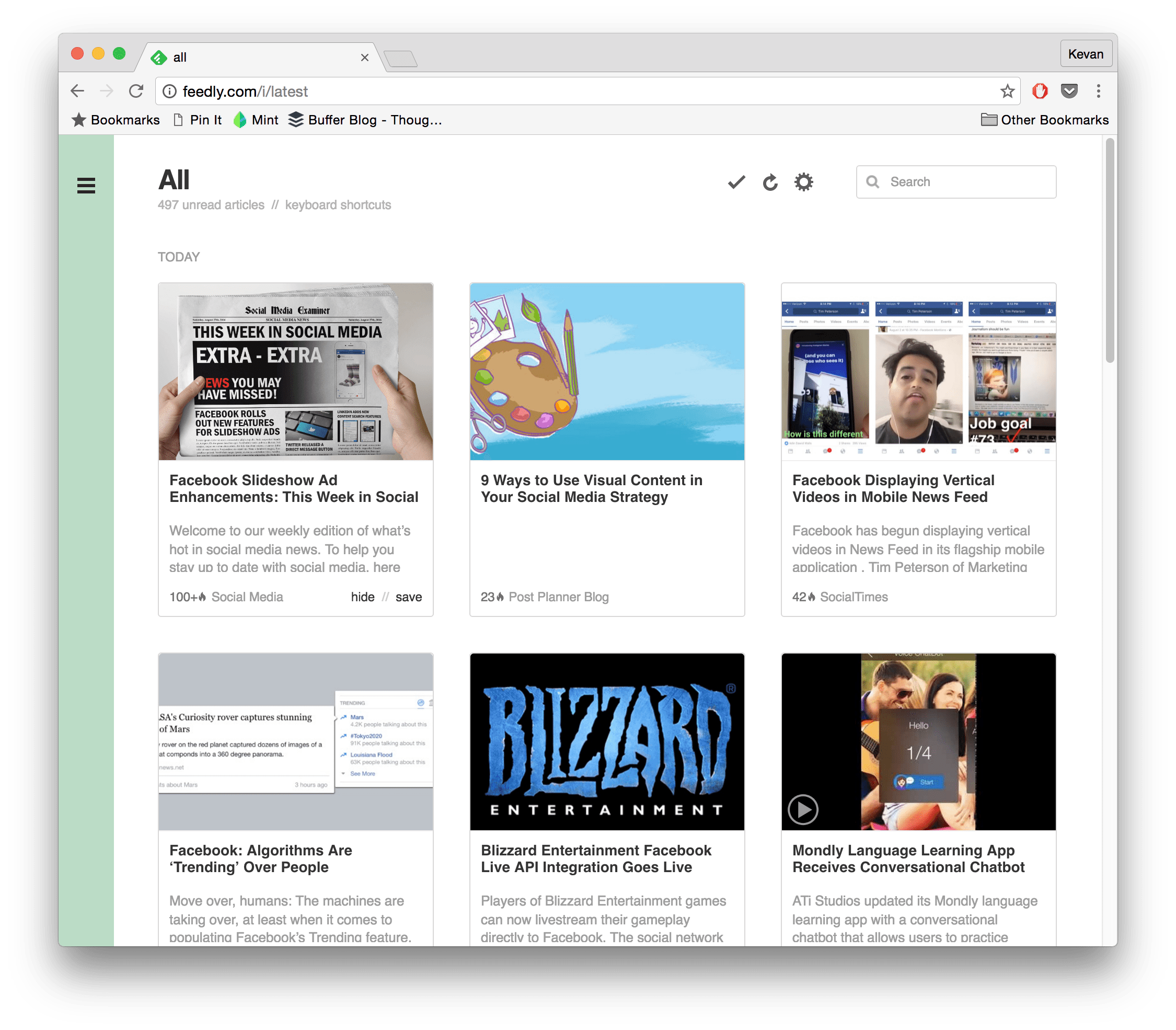
Price: Free
Feedly is the heir to Google Reader, and it’s improved the RSS formula in some neat ways. You can 1) search Feedly for topics to find the content you want to subscribe to. You can 2) integrate Feedly with other apps in order to make it easy to send stories to places like Pocket or Buffer. You can even do cool things like publicize your feed collections and check the virality of content based on its shares (great for curating in a pinch).
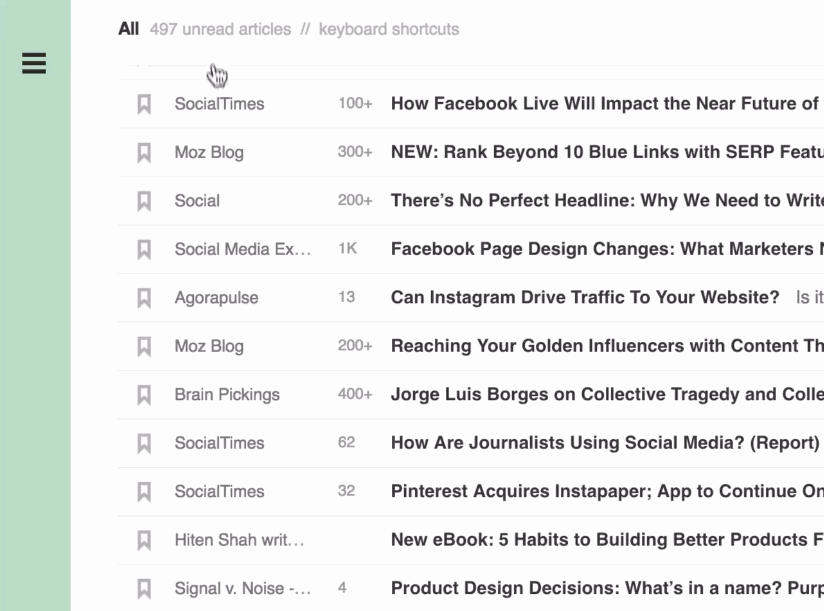
Other options:
4. Nuzzel – http://nuzzel.com
See what your friends are sharing on social media
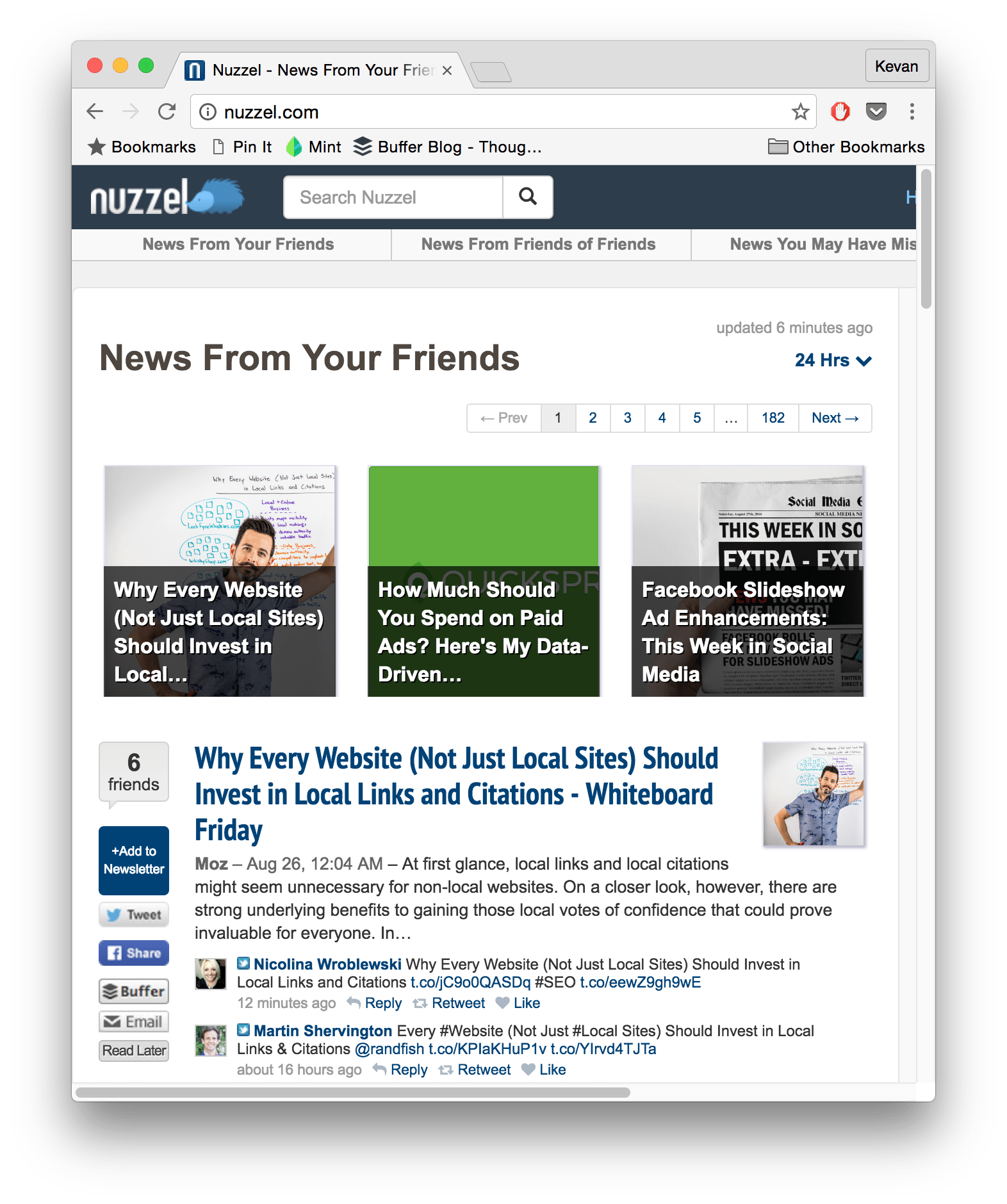
Price: Free
Nuzzel searches the feeds of your friends on Facebook and Twitter to find the content that they’re sharing. Everything gets ranked, then emailed to you once a day so you’re always in the loop. The top three stories make up the start of the email, then Nuzzel goes the extra mile with a Friends of Friends section with even more content. And if you’re wanting to go beyond the email, you can click through to the site to see everything that was shared that day.
Other options:
5. Goodbits – https://goodbits.io/
Ready-made email newsletters from the content you discover
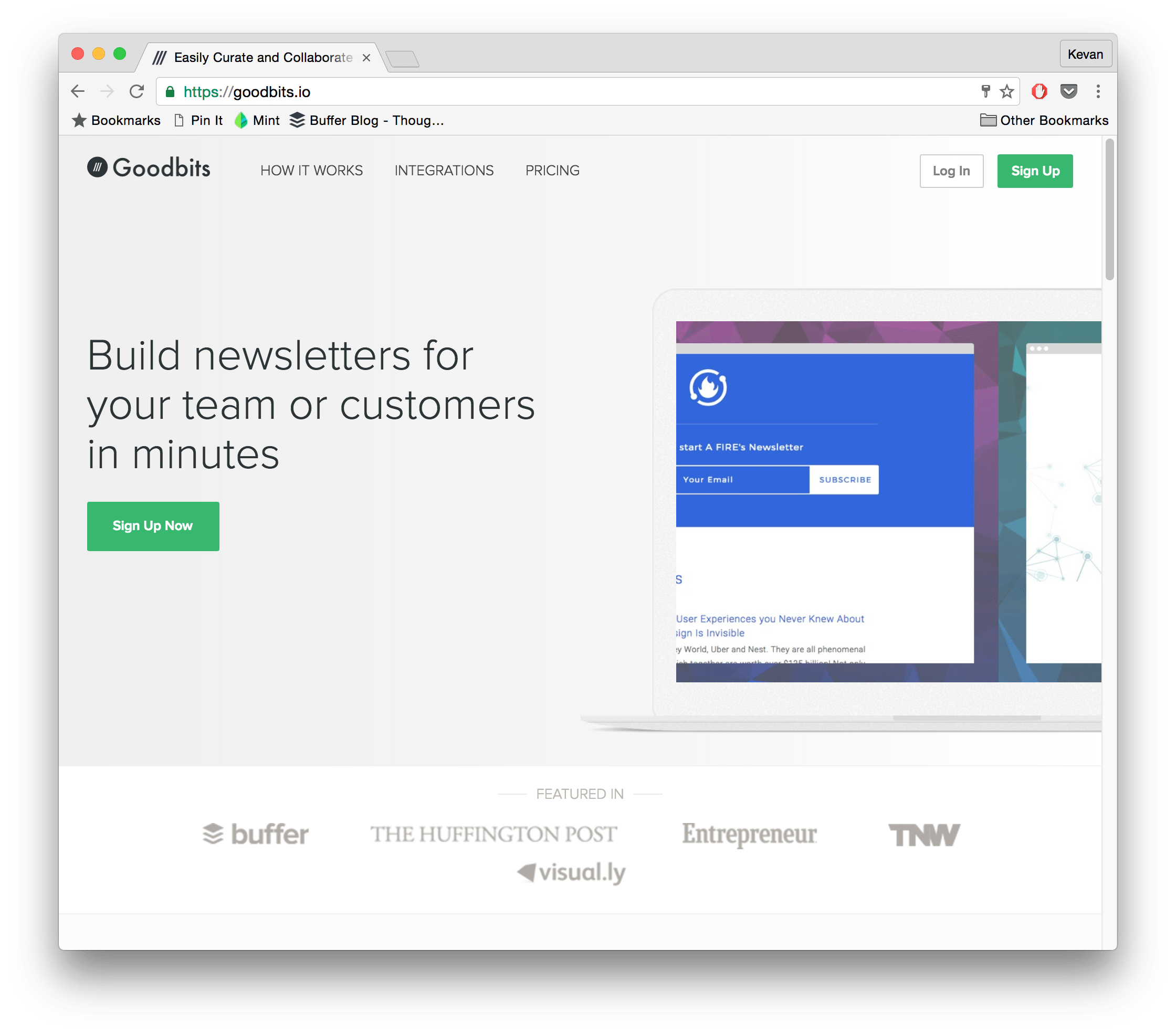
Price: Free
Goodbits removes the middleman/woman/spreadsheet from the flow of collecting great content and emailing links to great content. With Goodbits, you simply collect the content using their browser extension, and all the content is placed automatically into a pretty email that you can send to your subscribers. Goodbits integrates with popular email platforms like MailChimp and Campaign Monitor, and you can tie in RSS feeds directly to the Goodbits interface so you don’t even have to go looking for the content.
Other options:
6. TinyLetter – https://www.tinyletter.com
Straightforward newsletter building and sending
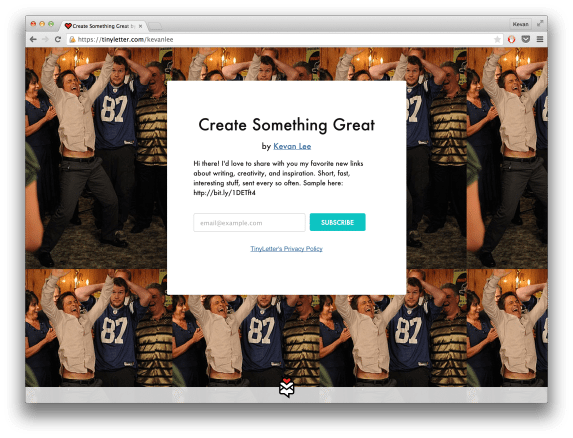
Price: free
One of the absolutely minimal ways for sending a newsletter is with TinyLetter. It’s completely no-frills, which means no barriers for entry. With TinyLetter, you get a straightforward landing page to collect emails and a clean and simple interface for writing your newsletter. And that’s it! There are some simple stats, but beyond that, all there is to do is write, send, repeat.
Other options:
7. Letterlist – http://letterlist.com
A list of the best, curated newsletters out there

Price: free
Remember the tip to curated from fellow curators? Well Letterlist collects the best curators for you. From the Letterlist website, you can subscribe to dozens of great newsletters.
It’s a curated list of curated newsletters, in order to help you curate.

Here are some more ideas of where you might find great content to curate …
Where to find great content: 17 vetted sources
Like we’ve talked about, the most important job of a high-quality curator is finding fantastic content. We’re lucky — there’s a lot of it out there!
Here are a few of our favorite places to look, both specifically (the sites themselves) and generally (the bigger-picture places). It’s important for me to remember that not everyone will be wishing to curate content based on startups, productivity, social media, or writing. Hopefully seeing some of our process might trigger some ideas for your particular industry.
1. Newsletters
I get a ton of value from the newsletters I subscribe to, both for the curation help they provide me and for just learning lots of interesting things. We’ve covered a list of over 60 favorite newsletters before. Definitely start there if you’re looking for a comprehensive list.
60+ Fantastic Email Newsletters to Read and Share
These are a few of the go-to ones I use currently:
SmartBrief also has a list of over 200 newsletters, segmented by industry. You might find something up your alley there.

2. Community aggregators
These are sites that are collecting content on their own and upvoting it so you can see what’s new and great.
3. Reddit
I thought about including this one in the list above for communities, but no, Reddit deserves a category all its own!
There are more than half-a-million subreddits, which are niche communities focused on a particular topic. These are basically community aggregators for anything you could imagine. Here are a few favorites:
(The Daily Dot ranks over 200 subreddits here.)
4. Content products
Another outcome of our content-heavy Internet is that there are entire products built for helping you find content. Thank you! These sites might either have algorithms that go out and source great stuff, or they have humans curate what they find to be worthy of a wider audience. Either way, these products are great for curation.
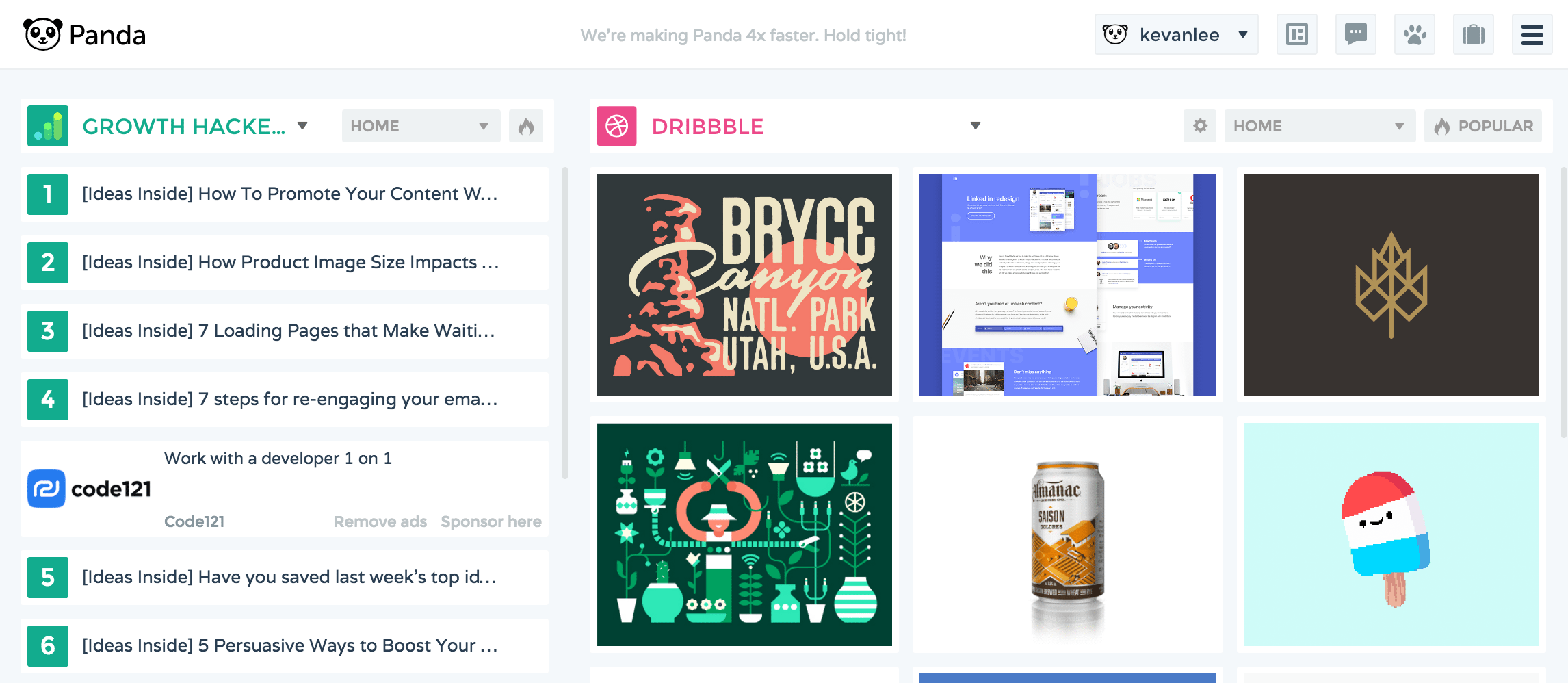
For even more content discovery ideas, we’ve put together some favorite lists here:
17 Unique Places to Find Great Content to Share
Advantages of being really good at content curation: Why people curate
By this point, you’ve likely got a good sense of what it takes to be really, really good at curation. And you might be wondering …
Why would someone go to these lengths?
Well first off, a lot of people enjoy it. Reading on the web is a wonderful leisure activity for many, so it must feel like such a gift to be able to build a following around what you’d be doing anyway.
That said, there are some specific brand advantages to being really, really good at curation. Whether you intend for these things to happen or not, they simply come with the territory of curating greatly. And if you do wish for any of the following to happen to your brand, then curation is the way to go!
1. Build authority
Awhile back, I made a purposeful decision to adjust my social media content and newsletter to focus on writing and social media. (I had to let go of the notion of building authority on my previous tweet fodder like football, soda pop, and Calvin and Hobbes comics.)
The result?
A jump in followers.
An increase in subscribers.
And, were there a way to measure these sorts of things, I imagine I also got a bump in authority.
When you choose to find, share, and comment on the best of the best articles in your industry, you will gain authority. If you do it consistently, you’ll build authority. People will look to you to see what’s happening and what’s worth discussing. It’s quite a special place to be, and one that I’m still working to achieve.
Once there, you have quite the platform for speaking and sharing on a topic.
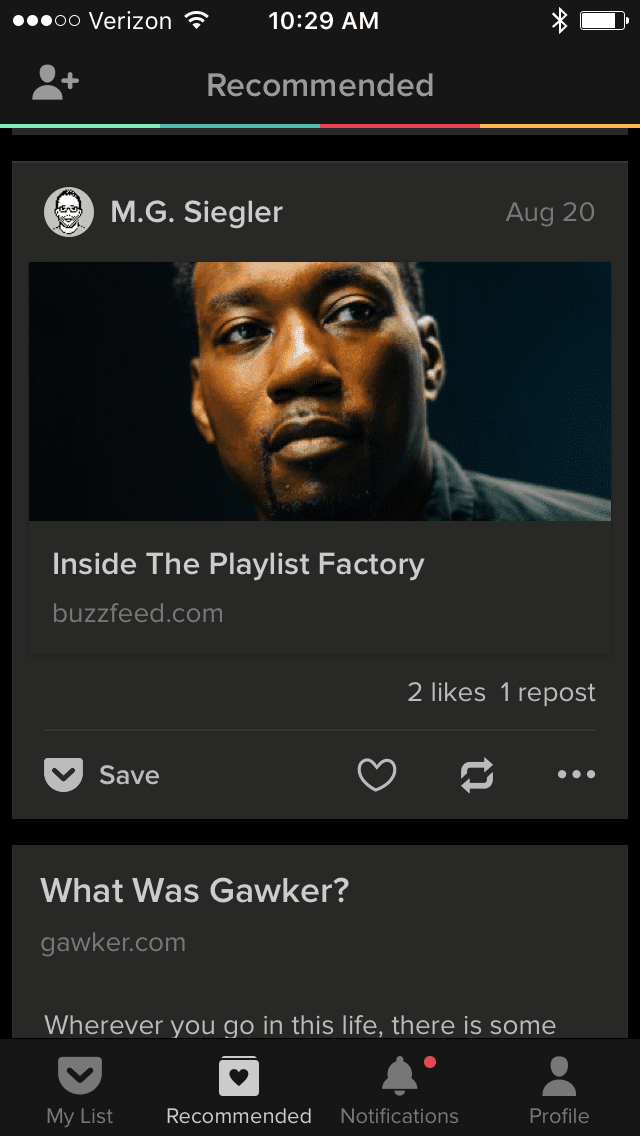
2. Gain influence
Along with building authority, curation also allows you to gain influence. We’re in a fortunate place at Buffer to have a pretty solid foundation of content and social sharing. As such, we get a lot of people reaching out to us to share this or that particular story.
They’d love for us to share because they feel we can influence others to click, share, read, etc.
You’ll find the same once you get in a solid groove with curation. Once people see that you curate great content, they’ll love to be considered along with the other great content you share.
3. Spread goodwill
With that influence comes the ability to honor others with a mention or share.
Curating content is one of the most generous things you can do online.
It’s a virtual high-five or tip jar, a Pay-It-Forward moment for whoever has the chance to catch your eye with a great article. What a good feeling! This one might not make the most immediate business impact, but it does help build relationships and engender positivity with others in your industry. Those relationships are key in the long run.
Who does it well: Curation heroes
We’ve taken a lot of inspiration from a number of folks in the startup space and content industry, people who do a sensational job of always having great stuff to share. It’s a good practice to curate from curators and also to learn from them.
Does anyone come to mind for you?
It can be as simple as noticing who in your social media feeds you tend to read most often, or which of your friends you most admire when they share new stuff. In one way, it’s a bit like venture capital; investor Ben Lerer has an interesting investment strategy: jealousy. He says:

Similarly, to find your curation heroes, you might check yourself for any moment you say, “Boy, I wish I had shared that.”
Here’s a list of a few heroes of ours at Buffer. Whether or not they match your industry or interests exactly, I hope you’ll be able to pick up a few trends or take some inspiration from the way they curate and share. A few things you might notice from this list:
- Many have been going at it for 5 to 10 years (Jason Kottke, Daring Fireball, Maria Popova)
- A few are senior-level executives or entrepreneurs (Rand Fishkin, Hiten Shah)
- Some are marketers like you and me (Courtney)
Translation: You can be yourself and still be fantastic with content curation.
Here’s the short list of curators I look up to.
1. Rand Fishkin, Moz founder
Hadn't been to Collector's Weekly before, but impressed w/ their content marketing efforts, e.g. https://t.co/GxIpgDbT4X
— Rand Fishkin (@randfish) August 26, 2016
Rand built the SEO company Moz, and he remains its chief evangelist through his videos, content, speaking, and curation. His Twitter feed is a goldmine of SEO and marketing tips and other interesting finds.
We had the privilege of having Rand on one of our upcoming Buffer podcast episodes. He shared a bit of his curation strategy with us along with these three takeaways for blending content, curation, and values:
- Everyone does best when they have a process and a set of guidelines.
- Don’t make the mistake of thinking that content is a short-term investment with a short-term payoff. It is absolutely not.
- When you are developing your values and committing to them, you need to also be aware that you’re going to have to need to go out and find like-minded people and a like-minded community that believe in those same values.
2. Hiten Shah, Crazy Egg & KISSmetrics founder, Quick Sprout co-founder
The Hype—and Hope—of Artificial Intelligence https://t.co/JbDsybXpRd pic.twitter.com/qS4Uw25aUJ
— Hiten Shah (@hnshah) August 26, 2016
Hiten is one of the smartest marketers out there and one of the most accomplished SaaS entrepreneurs and founders. His Twitter feed reflects his varied interests: lots of marketing, lots of tech, lots of innovative ideas, lots of, well, good stuff!
(Full disclosure: Hiten is one of our advisors at Buffer. We love him!)
3. Brain Pickings, curated by Maria Popova
One of the best sites out there for book lovers and inspiration seekers, Maria Popova’s Brain Pickings covers all sorts of different types of literature and dives deep into the topics and authors. Her curation is almost one of self-curation: She’s built up such a library that each new blog post is chock full of links to past ones. It’s making these connections from book to book and article to article where Maria really shines — and where she reveals a great opportunity for fellow curators.
4. Kottke.org, curated by Jason Kottke
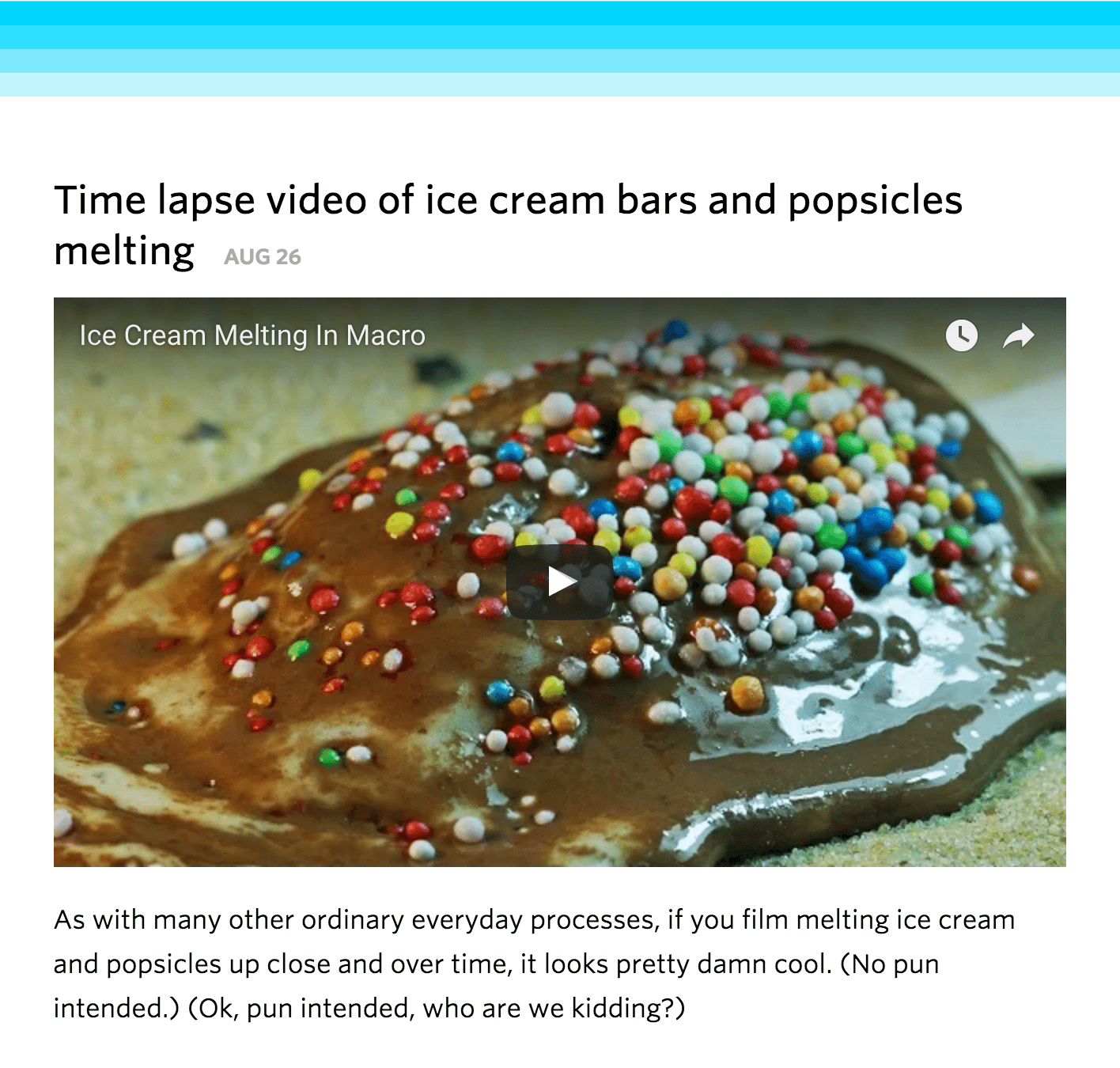
Jason Kottke’s website began 18 years ago and has evolved to cover art, media, and people doing awesome things. Jason shares five to ten interesting links per day on his site: stories, video, lists, news. He’s cornered the market on “huh, interesting” content, which is a great example for those feeling a bit too tied to one particular subject. As long as you have the market cornered on a feeling, that works too!
5. Daring Fireball, curated by John Gruber
Along with Jason Kottke, John Gruber was another of the original curators, starting Daring Fireball over a decade ago. The blog focuses on Apple technology and really blossomed in the heyday of iPhones and iPads.
John was recently a guest on the ReCode podcast where he shared behind-the-scenes about getting started with the blog and how he views the value that his curation and analysis brings to the Apple conversation.
6. Courtney Seiter, Buffer
The Only Technique To Learn Something New https://t.co/ACVJYR5S8K
— Courtney Seiter (@courtneyseiter) August 22, 2016
A couple years ago, Courtney led our content suggestions feature, and she singlehandedly curated 30+ unique pieces of content for every day of the week. It was the most prolific stretch of curation I’d ever witnessed — and people loved it. The content suggestions feature didn’t continue on, but Courtney’s work with curation was hugely instrumental toward delighting customers and teaching our marketing team what great content looked like (and how we could get there).
Bonus lesson of curation: You learn to recognize what’s good!
Next level content curation, feat. automation workflows
If you’ve read this far, thank you! There’s been a lot to digest, and hopefully it’s been encouraging to see what you can accomplish with great curation. Now the final steps are the ones that put curation into the advanced category and help you save even more time.
Ready?
Automated curation is your best time-saver. The more you can automate with your workflows, the more time you’ll save.
How do you automate? It all starts with tools like IFTTT and Zapier, apps that connect one service to another, triggering actions based on other actions. For instance, you can automatically add a new row to a spreadsheet every time you send a tweet.
Here’s a quick link to get started at IFTTT, which is completely free.
Here’s a quick link to get started at Zapier, which gives you the first five automations free then charges beyond that (Zapier has a great deal more services than IFTTT at the moment, which kind of balances things out).
Of course, there are many parts of curation that you can’t automate. You can’t automate good judgment or a strong eye toward quality or interestingness. You can’t automate the whole discovery phase of curation or, obviously, any of the reading part.
The most ground to be gained in automation will be with the sharing part of curation.
These are our favorite curation automations at Buffer.

Send your Pocket favorites straight to Buffer and schedule with an image
This one is pure gold for me. Every article I like in Pocket goes straight to Buffer, without me needing to a thing.
Once it’s in Buffer, I schedule time once a week to go through my backlog and prettify any of the updates that are in there — changing around the headlines or adding images. Here’s an example of one that Pocket/IFTTT/Buffer pulled in for me (before I changed a thing):

Alternative: You can also set up this IFTTT recipe to work with Pocket tags. If you have a tag like “Buffer” or “Social Media”, everything article you tag in this way will go straight to your Buffer queue in a single click.

Send your Pocket favorites to Trello
For a monthly newsletter, this Trello/Pocket combination comes in really handy. You can ask IFTTT or Zapier to create a new Trello card for you each time you favorite a story in Pocket. This way, when you’re ready to write your curated newsletter, you can simply pull all the links straight from your Trello board.
I use this one for my personal site and keep the links alongside my other blog notes and to-dos.
Curate Feedly to Email
(Recipe)
For those who love as much of their curation as possible to happen in email, this recipe makes it possible to bring Feedly in there. All your Feedly content is sent as an email digest where you can choose what to read or skip.
Your turn: Let us know how your curation goes!
Phew! Thanks for hanging with us the whole way. I hope the info here has been helpful for you and has maybe even inspired a content curation strategy that you’ll be excited to try.
If you’re curating content, mind sharing with us where we can follow along?
It’d be great to see what you’re finding!
And if you have any tips for us on what’s been working for you, or if you have any questions about anything we’ve mentioned here, feel free to drop a mention in the comments. I’ll be hanging out there and would love to chat!
Happy curating!
Image sources: UnSplash







